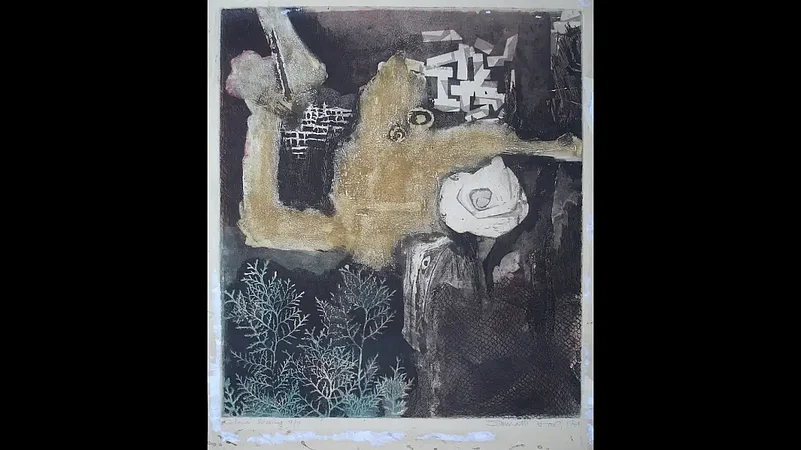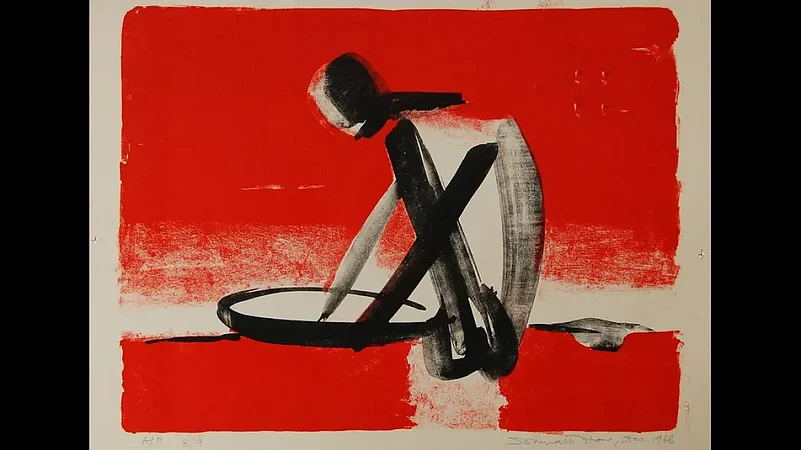Considered as one of India’s best printmakers, Somnath Hore (1921-2006) is known for his poignant expression of sufferings of people. And here is your chance to get an overview of the reputed artist’s works at an exhibition in Kolkata organised by Emami Art in partnership with Arthshila Foundation Santiniketan (an art-focused initiative of Takshila Educational Society). Titled Somnath Hore: A centenary exhibition, it is curated by K.S. Radhakrishnan and explores the different facets of the artist.
Somnath Hore was born in undivided Bengal’s Chittagong district (now in Bangladesh). He joined the Indian College of Art to set up a printmaking department. In 1958 he joined the Arts Faculty of the Delhi Polytechnic as a lecturer. In 1962, he experimented with printmaking using electrolysis, creating copper silt on zinc plates. In 1969, he joined full-time as the Head of the Graphic Arts Department, Kala Bhavan, Santiniketan, retiring in 1983. In 2007 Somnath Hore was awarded the Padma Bhushan posthumously.
Advertisement
Through his career, Hore was deeply moved by the Bengal famine (1943) and the peasant’s uprising called Tebhaga Movement (1946-47); many of his works are moving expressions of the sufferings of people under various circumstances, ranging from life of tea workers to Vietnam War. Among the original works exhibited here are works from his famous ‘Wounds Series’. It was around 1970 when he started the 'Wounds' series - a new abstract style of white-on-white paper pulp prints.

The nonlinear exhibition covers Hore’s works across different periods, including works from an unpublished sketchbook of his drawings of daily life in Santiniketan from 1987-88. The exhibition includes intaglio prints from his period in Delhi in the 1960s (including his masterpiece the Birth of a White Rose, 1961, which fetched him the National Award) as well as etchings, drawings, and paintings from different periods, done in different methods. The exhibition showcases some of his early works (woodcut prints) from the 1940s-1950s (including iconic works like Ratey Khuli Baithak, 1946 and Budhiya Barmaner Ma, 1946).
Advertisement
The exhibition further delves into his lesser known works (digital reproductions of his oil paintings from the 1950s) and several woodcut prints. The exhibition showcases digital reproductions of images of his ‘bronze’ sculptures as well. By 1974, he had started experimenting with wax sculpting. After retiting from Kala Bhavan, he started working on sculptures. There is also a display of pages of a sketchbook from 1997-98 with pen-and-ink sketches of everyday scenes from Santiniketan.
In the words of sculptor KS Radhakrishnan, who has curated the show, “This exhibition puts together Somnath Hore's work (or photographic documentation of his work) across all the mediums he worked in and across all the decades of his creative life. It is a tribute to his extraordinarily empathetic and emotional nature, which witnessed the Second World War, the Bengal Famine, the quiet suffering of the peasants, workers and destitute whom he documented... and made their pain the mainstay of his art forever. The form, as well as content of his art, kept changing but the pain remained constant, even deepened, and found newer modes of expression.”
Information: Somnath Hore: A centenary exhibition, open to all, is on view until July 24, 2022, from 11am to 6pm, on the fourth floor at Emami Art, located inside Kolkata Centre for Creativity, 777 Anandapur (off EM Bypass), Kolkata 700107.
While there, you may also stop by two other interesting exhibitions, which are on view till August 20.
Curated by Ina Puri, ‘Singed But Not Burnt’ is a retrospective style photographic exhibition of the works of Shahidul Alam, renowned photographer who is also a writer, an activist and an institution-builder. The exhibition reflects Alam’s engagement with issues relating to equality for all as well as his lifelong mission to make visual literacy accessible to everyone through images.
Advertisement
Curated by Nancy Adajania, 'The Dark Edge of Green' is a retrospective-scale exhibition of works by Arunima Choudhury, one of the popular contemporary artists from West Bengal. Besides paintings, rendered both in acrylic and vegetable colour, the artist's most preferred medium, her remarkable but rarely shown fabric, ceramic, and enamel works are also on view.




















